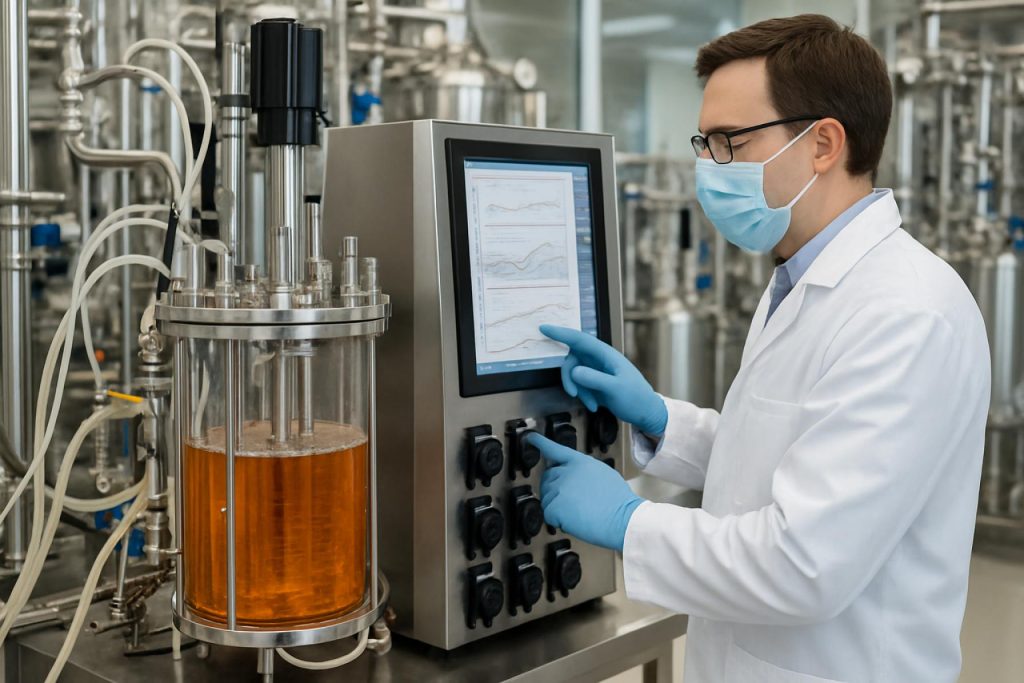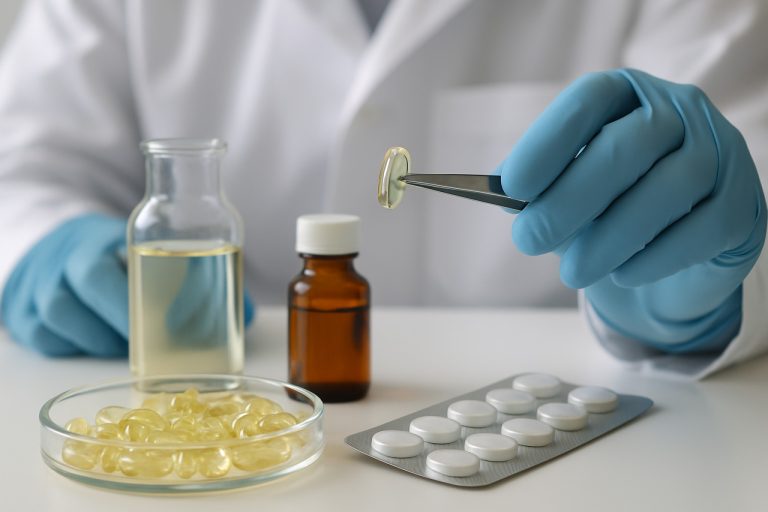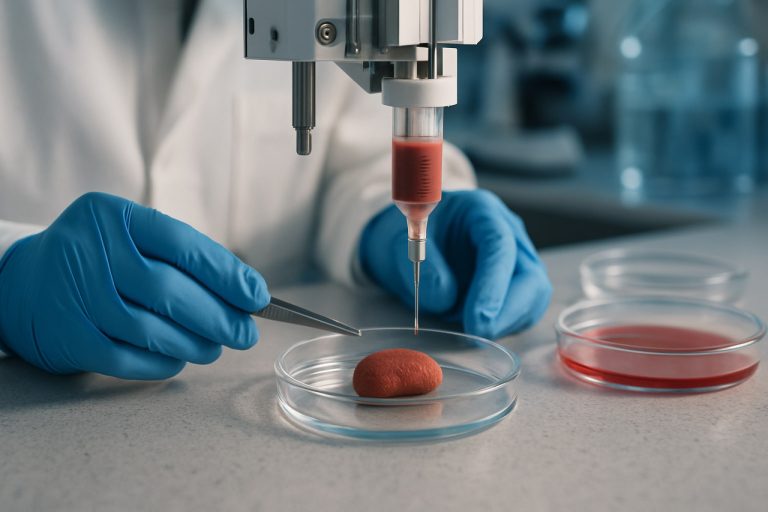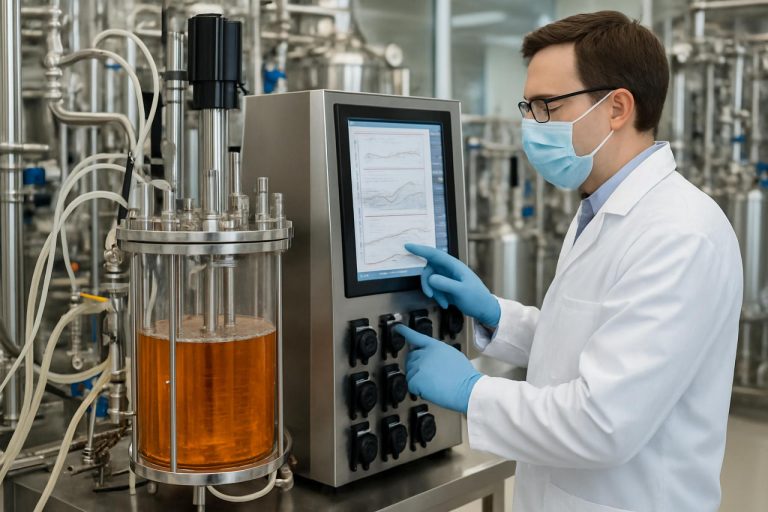
Unlocking the Future of Bioprocess Optimization Platforms in 2025: How Next-Gen Technologies Are Transforming Biomanufacturing Efficiency and Market Dynamics. Discover the Key Drivers, Innovations, and Growth Opportunities Shaping the Industry.
- Executive Summary: Market Size, Growth, and Key Trends (2025–2030)
- Technology Landscape: AI, Automation, and Digital Twins in Bioprocess Optimization
- Market Drivers: Demand for Biologics, Personalized Medicine, and Sustainability
- Competitive Analysis: Leading Companies and Strategic Initiatives
- Regulatory Environment and Industry Standards
- Case Studies: Successful Implementation in Biopharma and Industrial Biotech
- Challenges and Barriers: Integration, Scalability, and Data Security
- Market Forecast: Revenue Projections and CAGR Analysis (2025–2030)
- Emerging Opportunities: Continuous Processing and Real-Time Analytics
- Future Outlook: Innovation Roadmap and Strategic Recommendations
- Sources & References
Executive Summary: Market Size, Growth, and Key Trends (2025–2030)
The global market for bioprocess optimization platforms is poised for robust growth between 2025 and 2030, driven by the accelerating adoption of digitalization, automation, and artificial intelligence (AI) in biomanufacturing. As biopharmaceutical companies intensify efforts to improve yield, reduce costs, and ensure regulatory compliance, demand for advanced software and integrated hardware solutions is surging. In 2025, the market is estimated to be valued in the low single-digit billions (USD), with compound annual growth rates (CAGR) projected in the low to mid-teens through 2030, reflecting both expansion in established markets and rapid uptake in emerging regions.
Key industry players are investing heavily in platform development and strategic partnerships. Sartorius AG continues to expand its Biostat and Ambr platforms, integrating real-time analytics and process control modules to enable continuous monitoring and adaptive optimization. Merck KGaA (operating as MilliporeSigma in the US and Canada) is advancing its Bio4C™ Software Suite, which leverages cloud-based data management and predictive analytics to streamline upstream and downstream processes. Cytiva (formerly part of GE Healthcare Life Sciences) is enhancing its Chronicle™ automation platform, focusing on seamless data integration and process scalability for both clinical and commercial manufacturing.
The integration of AI and machine learning is a defining trend, with companies such as Thermo Fisher Scientific embedding advanced algorithms into their bioprocessing solutions to enable predictive maintenance, anomaly detection, and real-time process optimization. Meanwhile, Danaher Corporation (through subsidiaries like Pall and Cytiva) is investing in modular, flexible platforms that support both traditional and next-generation modalities, including cell and gene therapies.
Regulatory agencies are increasingly supportive of digital transformation, encouraging the adoption of process analytical technology (PAT) and Quality by Design (QbD) principles. This regulatory momentum is expected to further accelerate platform adoption, particularly as manufacturers seek to reduce time-to-market for new biologics and biosimilars.
Looking ahead, the market outlook remains highly positive. The convergence of bioprocessing with digital technologies is expected to yield significant efficiency gains, cost reductions, and improved product quality. As biomanufacturers scale up production of complex biologics, vaccines, and personalized medicines, bioprocess optimization platforms will become indispensable tools, underpinning the next wave of innovation and competitiveness in the life sciences sector.
Technology Landscape: AI, Automation, and Digital Twins in Bioprocess Optimization
The landscape of bioprocess optimization platforms is undergoing rapid transformation in 2025, driven by the convergence of artificial intelligence (AI), automation, and digital twin technologies. These advancements are enabling biomanufacturers to achieve unprecedented levels of process control, efficiency, and scalability, particularly in the production of biologics, cell and gene therapies, and novel bioproducts.
AI-powered platforms are now central to bioprocess optimization, leveraging machine learning algorithms to analyze vast datasets from process sensors, historical runs, and quality outputs. This data-driven approach allows for real-time prediction and adjustment of critical process parameters, reducing batch failures and improving yield. Companies such as Sartorius and Cytiva have integrated AI modules into their bioprocessing suites, offering predictive analytics and automated control systems that adapt to process variability. These platforms are increasingly cloud-based, facilitating remote monitoring and multi-site collaboration.
Automation is another cornerstone of current bioprocess optimization. Robotic systems and automated sampling devices are minimizing manual intervention, reducing contamination risks, and enabling continuous processing. Thermo Fisher Scientific and Merck KGaA (operating as MilliporeSigma in the US and Canada) have expanded their portfolios with modular, automated bioprocessing solutions that integrate seamlessly with digital control platforms. These systems are designed for flexibility, supporting both small-scale development and large-scale commercial manufacturing.
Digital twins—virtual replicas of physical bioprocesses—are gaining traction as a transformative tool for process optimization. By simulating process dynamics in silico, digital twins enable rapid scenario testing, process troubleshooting, and technology transfer. Siemens and GE HealthCare are at the forefront, offering digital twin solutions that synchronize with real-time process data, providing actionable insights for process engineers and operators. These platforms are being adopted not only by large pharmaceutical manufacturers but also by emerging biotech firms seeking to accelerate development timelines and reduce costs.
Looking ahead, the next few years are expected to see further integration of AI, automation, and digital twins into unified bioprocess optimization platforms. The focus will be on interoperability, data standardization, and regulatory compliance, as industry bodies such as the International Society for Pharmaceutical Engineering (ISPE) promote best practices for digital transformation. As these technologies mature, they are poised to drive the next wave of innovation in biomanufacturing, enabling more agile, resilient, and sustainable production systems.
Market Drivers: Demand for Biologics, Personalized Medicine, and Sustainability
The market for bioprocess optimization platforms is experiencing robust growth in 2025, driven by the escalating demand for biologics, the rise of personalized medicine, and an industry-wide push for sustainability. Biologics—including monoclonal antibodies, cell and gene therapies, and vaccines—continue to dominate pharmaceutical pipelines, necessitating advanced manufacturing solutions that can deliver higher yields, improved quality, and reduced costs. This demand is compelling biomanufacturers to adopt digital and automated bioprocess optimization platforms that leverage real-time data analytics, artificial intelligence (AI), and machine learning (ML) to streamline production.
Key industry players such as Sartorius, Merck KGaA, and Cytiva are at the forefront, offering integrated solutions that combine process analytical technologies (PAT), digital twins, and advanced control systems. For example, Sartorius has expanded its Bioprocess Solutions segment, focusing on digital tools that enable predictive modeling and real-time process adjustments, which are critical for scaling up biologics production efficiently. Similarly, Merck KGaA’s BioContinuum™ Platform integrates automation and analytics to support continuous bioprocessing, a key trend for both efficiency and sustainability.
Personalized medicine is another major driver, as therapies tailored to individual patients—such as CAR-T cell therapies—require flexible, small-batch manufacturing. This shift is accelerating the adoption of modular and scalable bioprocess platforms that can rapidly adapt to changing production needs. Companies like Thermo Fisher Scientific are investing in digital bioprocessing solutions that facilitate rapid process development and tech transfer, supporting the fast-paced clinical and commercial timelines of personalized therapies.
Sustainability is increasingly central to bioprocess optimization strategies. The industry is under pressure to reduce its environmental footprint by minimizing resource consumption, waste, and energy use. Bioprocess platforms now incorporate features such as single-use technologies, process intensification, and closed-system operations, which collectively enhance efficiency and reduce contamination risks. Cytiva and Sartorius are both advancing single-use bioreactor systems and digital monitoring tools that support greener manufacturing practices.
Looking ahead, the outlook for bioprocess optimization platforms remains strong. The convergence of digitalization, automation, and sustainability is expected to further transform biomanufacturing over the next few years. As regulatory agencies increasingly endorse real-time release and continuous manufacturing, adoption of these platforms is set to accelerate, enabling the industry to meet the growing global demand for safe, effective, and sustainable biologics.
Competitive Analysis: Leading Companies and Strategic Initiatives
The bioprocess optimization platforms market in 2025 is characterized by rapid technological advancements and strategic collaborations among leading industry players. These platforms, which integrate automation, data analytics, and artificial intelligence (AI), are pivotal in enhancing the efficiency, scalability, and reproducibility of biomanufacturing processes. The competitive landscape is shaped by established bioprocess equipment manufacturers, digital solution providers, and emerging biotech firms, each leveraging unique strengths to capture market share.
A dominant force in this sector is Sartorius AG, which continues to expand its portfolio of digital bioprocess solutions. Sartorius’s Biostat STR and Ambr platforms, combined with its data analytics suite, are widely adopted for upstream process optimization. The company’s strategic focus on integrating AI-driven predictive analytics and cloud-based process monitoring is expected to further solidify its leadership through 2025 and beyond.
Another key player, Merck KGaA (operating as MilliporeSigma in the US and Canada), has invested heavily in its BioContinuum Platform, which offers end-to-end digitalization of bioprocess workflows. Merck’s recent partnerships with automation and software firms aim to accelerate the adoption of continuous manufacturing and real-time process control, positioning the company at the forefront of next-generation bioprocessing.
Thermo Fisher Scientific Inc. is also a major competitor, offering integrated bioprocess optimization tools such as the HyPerforma bioreactor series and the Gibco Process Optimization Service. Thermo Fisher’s strategy emphasizes modular, scalable solutions and the incorporation of advanced sensors and machine learning algorithms to enable adaptive process control.
Emerging companies are also making significant inroads. Cytiva (formerly part of GE Healthcare Life Sciences) has expanded its digital bioprocessing capabilities through the Chronicle automation platform and collaborations with software innovators. Meanwhile, Eppendorf SE is enhancing its bioprocess control systems with cloud connectivity and user-friendly interfaces, targeting small- to mid-scale biomanufacturers.
Looking ahead, the competitive landscape is expected to intensify as companies pursue strategic acquisitions, joint ventures, and R&D investments to address the growing demand for flexible, data-driven bioprocessing. The integration of AI, IoT, and advanced analytics will remain central to differentiation, with leading firms focusing on interoperability and regulatory compliance to support the evolving needs of biopharmaceutical manufacturers worldwide.
Regulatory Environment and Industry Standards
The regulatory environment for bioprocess optimization platforms is evolving rapidly in 2025, reflecting the increasing integration of digital technologies, automation, and data analytics in biomanufacturing. Regulatory agencies such as the U.S. Food and Drug Administration (FDA) and the European Medicines Agency (EMA) are actively updating guidelines to accommodate the use of advanced process control, real-time monitoring, and artificial intelligence (AI) in bioprocessing. The FDA’s continued emphasis on the principles of Process Analytical Technology (PAT) and Quality by Design (QbD) is driving the adoption of platforms that enable real-time data collection and process optimization, ensuring product quality and regulatory compliance.
Industry standards are being shaped by organizations such as the International Society for Pharmaceutical Engineering (ISPE) and the International Organization for Standardization (ISO). ISPE’s guidelines on digital transformation and Pharma 4.0 are particularly influential, promoting the use of interoperable, data-driven platforms that support continuous improvement and regulatory transparency. ISO standards, including ISO 9001 for quality management systems and ISO 13485 for medical devices, are increasingly referenced in the development and validation of bioprocess optimization tools.
Leading technology providers are collaborating with regulatory bodies to ensure their platforms meet evolving compliance requirements. For example, Siemens and GE HealthCare are actively involved in industry consortia and standardization initiatives, contributing to the development of best practices for digital bioprocessing. These companies offer platforms that integrate advanced analytics, automation, and cloud connectivity, supporting both regulatory submissions and ongoing process validation.
Data integrity and cybersecurity are also central to the regulatory landscape in 2025. Regulatory agencies are issuing updated guidance on electronic records and data management, emphasizing the need for secure, auditable, and traceable systems. Bioprocess optimization platforms are increasingly required to comply with standards such as 21 CFR Part 11 in the U.S. and Annex 11 in the EU, which govern electronic records and signatures.
Looking ahead, the regulatory outlook for bioprocess optimization platforms is expected to become more harmonized globally, with increased collaboration between agencies and industry stakeholders. The adoption of digital twins, AI-driven process control, and cloud-based data management will continue to shape regulatory expectations, requiring ongoing adaptation by platform providers and manufacturers. Companies that proactively engage with regulators and standards organizations are likely to be best positioned to navigate this dynamic environment and accelerate the adoption of innovative bioprocess optimization solutions.
Case Studies: Successful Implementation in Biopharma and Industrial Biotech
Bioprocess optimization platforms have become pivotal in advancing both biopharmaceutical and industrial biotechnology sectors, particularly as the industry faces increasing pressure to enhance efficiency, reduce costs, and accelerate time-to-market. In 2025, several case studies highlight the successful deployment of these platforms, demonstrating tangible improvements in process control, scalability, and product quality.
One notable example is the adoption of digital bioprocess optimization tools by Sartorius, a global leader in bioprocess solutions. Sartorius has integrated advanced data analytics and machine learning algorithms into its Biostat STR and Ambr platforms, enabling real-time monitoring and predictive control of critical process parameters. In recent collaborations with major biopharma manufacturers, these platforms have facilitated a 20–30% reduction in process development timelines and improved batch-to-batch consistency, as reported in their 2024–2025 performance updates.
Similarly, Cytiva has expanded its Chronicle automation software and FlexFactory platform, which are now widely used in continuous bioprocessing. In a 2025 case study with a leading monoclonal antibody producer, Cytiva’s integrated platform enabled seamless scale-up from lab to commercial production, reducing process deviations by over 40% and supporting regulatory compliance through comprehensive data integrity features.
In the industrial biotech space, DSM has leveraged bioprocess optimization platforms to enhance the production of specialty enzymes and bio-based chemicals. By implementing advanced process analytical technology (PAT) and digital twins, DSM reported a 15% increase in yield and a significant reduction in raw material usage across several manufacturing sites in 2025. These improvements align with DSM’s sustainability goals and demonstrate the scalability of digital optimization in large-scale fermentation.
Another significant player, GEA Group, has focused on modular bioprocessing systems equipped with integrated sensors and cloud-based analytics. In partnership with contract development and manufacturing organizations (CDMOs), GEA’s solutions have enabled rapid process optimization and technology transfer, particularly for vaccine and cell therapy production. Their 2025 deployments have shown up to 25% faster process validation cycles, supporting the accelerated launch of new therapies.
Looking ahead, the continued convergence of automation, artificial intelligence, and cloud computing is expected to further enhance bioprocess optimization platforms. Industry leaders are investing in open, interoperable systems to facilitate data sharing and collaborative innovation, setting the stage for even greater efficiency and flexibility in biomanufacturing over the next few years.
Challenges and Barriers: Integration, Scalability, and Data Security
Bioprocess optimization platforms are rapidly evolving, but their widespread adoption faces significant challenges related to integration, scalability, and data security—issues that are particularly acute as the industry moves into 2025 and beyond. The integration of advanced digital tools with legacy bioprocessing equipment remains a persistent barrier. Many biomanufacturers operate facilities with heterogeneous systems, making seamless data flow and process harmonization difficult. For example, companies like Sartorius and Merck KGaA have invested in modular, interoperable software suites, yet the need for custom interfaces and middleware persists, slowing down full digital transformation.
Scalability is another critical concern. While pilot-scale optimization platforms demonstrate impressive gains in yield and efficiency, translating these results to commercial-scale production is non-trivial. The complexity of scaling up bioprocesses—where small changes can have outsized impacts on product quality—demands robust, validated digital twins and predictive models. Cytiva and Thermo Fisher Scientific are among the leaders developing scalable, cloud-based solutions, but even their platforms require significant customization for each facility and process. The lack of standardized data formats and protocols further complicates efforts to scale digital solutions across global manufacturing networks.
Data security and regulatory compliance are increasingly prominent barriers as bioprocess optimization platforms become more connected and cloud-enabled. The sensitive nature of bioprocess data—often including proprietary cell line information and batch records—makes cybersecurity a top priority. In 2025, companies are investing heavily in secure data architectures and compliance with evolving standards such as GAMP 5 and FDA 21 CFR Part 11. Siemens and GE HealthCare are notable for integrating advanced encryption and access controls into their industrial automation and digitalization offerings. However, the threat landscape is dynamic, and the industry must remain vigilant against emerging risks such as ransomware and supply chain attacks.
Looking ahead, the sector is expected to see increased collaboration between platform providers, equipment manufacturers, and regulatory bodies to address these challenges. Initiatives to develop open standards and interoperable frameworks are gaining momentum, with organizations like the BioPhorum Operations Group playing a coordinating role. Nevertheless, overcoming integration, scalability, and data security barriers will require sustained investment and a willingness to embrace new business models and partnerships throughout the bioprocessing value chain.
Market Forecast: Revenue Projections and CAGR Analysis (2025–2030)
The global market for bioprocess optimization platforms is poised for robust growth between 2025 and 2030, driven by the increasing adoption of digitalization, automation, and advanced analytics in biomanufacturing. As biopharmaceutical companies intensify efforts to improve yield, reduce costs, and accelerate time-to-market, demand for integrated software and hardware solutions is surging. Key industry players, including Sartorius AG, Merck KGaA, Thermo Fisher Scientific, and Cytiva, are expanding their portfolios with advanced process analytical technologies (PAT), machine learning-driven control systems, and cloud-based data management platforms.
Revenue projections for the bioprocess optimization platforms market indicate a compound annual growth rate (CAGR) in the range of 12% to 15% through 2030, with global revenues expected to surpass USD 5 billion by the end of the forecast period. This growth is underpinned by the rapid expansion of biologics manufacturing, including monoclonal antibodies, cell and gene therapies, and vaccines. The increasing complexity of these products necessitates sophisticated optimization tools to ensure consistent quality and regulatory compliance.
In 2025, North America and Europe are anticipated to remain the largest markets, owing to the concentration of leading biopharmaceutical manufacturers and early adoption of digital bioprocessing solutions. However, Asia-Pacific is projected to exhibit the fastest growth, fueled by significant investments in biomanufacturing infrastructure and government initiatives supporting local production capabilities. Companies such as Sartorius AG and Merck KGaA have announced strategic expansions and partnerships in the region to capture emerging opportunities.
The outlook for the next few years is characterized by increasing integration of artificial intelligence and real-time analytics into bioprocess platforms. For example, Thermo Fisher Scientific and Cytiva are investing in cloud-enabled solutions that facilitate remote monitoring, predictive maintenance, and adaptive process control. These innovations are expected to drive further market penetration, particularly among contract development and manufacturing organizations (CDMOs) seeking to differentiate their service offerings.
Overall, the bioprocess optimization platforms market is set for sustained expansion through 2030, propelled by technological advancements, regulatory pressures for process robustness, and the ongoing shift toward continuous manufacturing paradigms.
Emerging Opportunities: Continuous Processing and Real-Time Analytics
The landscape of bioprocess optimization platforms is rapidly evolving in 2025, driven by the convergence of continuous processing technologies and real-time analytics. These advancements are enabling biomanufacturers to achieve higher yields, improved product quality, and greater operational efficiency. The shift from traditional batch processing to continuous bioprocessing is particularly notable, as it allows for more consistent product output and streamlined scale-up, addressing longstanding challenges in biologics and cell therapy production.
Key industry players are investing heavily in integrated platforms that combine process automation, advanced sensors, and data analytics. Sartorius AG has expanded its portfolio with modular bioprocessing solutions that support both batch and continuous operations, emphasizing real-time monitoring and control. Their systems leverage multi-parameter sensors and software to provide actionable insights, enabling dynamic process adjustments and reducing downtime.
Similarly, Merck KGaA (operating as MilliporeSigma in the US and Canada) has introduced next-generation bioprocessing platforms that integrate continuous chromatography and single-use technologies. These platforms are designed to facilitate seamless data capture and analysis, supporting predictive maintenance and process optimization. Merck’s focus on digitalization is evident in their partnerships with automation and analytics providers, aiming to deliver end-to-end solutions for biomanufacturers.
Another significant contributor, GE HealthCare (formerly part of GE Life Sciences), continues to develop its Bioprocessing business with a strong emphasis on digital twins and process analytical technology (PAT). Their platforms enable real-time simulation and optimization of bioprocesses, reducing development timelines and enhancing reproducibility. The adoption of digital twins is expected to accelerate in the coming years, as companies seek to de-risk scale-up and regulatory submissions.
The integration of artificial intelligence (AI) and machine learning (ML) is also gaining momentum. Cytiva (a Danaher company) is actively deploying AI-driven analytics within its bioprocessing solutions, allowing for predictive control and anomaly detection. These capabilities are particularly valuable in continuous processing environments, where rapid response to process deviations is critical.
Looking ahead, the next few years are expected to see broader adoption of continuous bioprocessing and real-time analytics across both established pharmaceutical manufacturers and emerging biotech firms. Regulatory agencies are increasingly supportive of these innovations, recognizing their potential to enhance product safety and supply chain resilience. As digital infrastructure matures and interoperability improves, bioprocess optimization platforms will play a central role in the future of biomanufacturing, driving both productivity and innovation.
Future Outlook: Innovation Roadmap and Strategic Recommendations
Bioprocess optimization platforms are at the forefront of transforming biomanufacturing, with 2025 marking a pivotal year for the integration of advanced digital tools, automation, and artificial intelligence (AI) into process development and production. The future outlook for these platforms is shaped by the convergence of several technological and strategic trends, as well as the growing demand for efficiency, scalability, and sustainability in bioprocessing.
A key innovation trajectory is the expansion of end-to-end digitalization. Leading bioprocess technology providers are investing heavily in cloud-based data management, real-time analytics, and digital twins to enable predictive modeling and process control. For example, Sartorius AG has been advancing its Bioprocess Solutions segment with integrated software suites that connect laboratory, pilot, and manufacturing data, aiming to reduce development timelines and improve reproducibility. Similarly, Cytiva is focusing on digital platforms that unify process data and facilitate rapid scale-up, with a strong emphasis on user-friendly interfaces and interoperability across equipment.
Automation and robotics are expected to play an increasingly central role in the next few years. Companies such as Thermo Fisher Scientific are deploying automated bioprocessing workstations and robotic liquid handlers to minimize manual intervention, reduce error rates, and enable high-throughput experimentation. These systems are being coupled with AI-driven analytics to optimize parameters in real time, accelerating process development cycles and supporting continuous manufacturing paradigms.
Another significant trend is the integration of advanced sensors and process analytical technologies (PAT). Merck KGaA (operating as MilliporeSigma in the US and Canada) is developing next-generation PAT tools that provide in-line, real-time monitoring of critical quality attributes, supporting adaptive process control and compliance with regulatory expectations for data integrity and traceability.
Strategically, bioprocess optimization platforms are moving toward greater modularity and flexibility to accommodate diverse modalities, including cell and gene therapies, mRNA vaccines, and novel biologics. This is driving partnerships between technology providers and biomanufacturers to co-develop tailored solutions and ensure rapid technology transfer. Industry consortia and standards bodies are also working to harmonize data formats and communication protocols, which will be crucial for seamless integration across the bioprocessing value chain.
Looking ahead, the next few years will likely see accelerated adoption of these platforms, driven by the need for faster product development, cost containment, and robust supply chains. Companies that invest in digital infrastructure, automation, and collaborative innovation are expected to gain a competitive edge, while the broader industry will benefit from increased agility and resilience in biomanufacturing.



